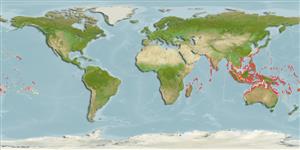>
Ovalentaria/misc (Various families in series Ovalentaria) >
Pomacentridae (Damselfishes) > Chrominae
Etymology: Chromis: Greek, chromis = a fish, perhaps a perch (Ref. 45335).
More on authors: Welander & Schultz.
Environment: milieu / climate zone / intervalo de profundidade / distribution range
Ecologia
marinhas associadas(os) a recifes; não migratória; intervalo de profundidade 1 - 29 m (Ref. 9710). Tropical; 32°N - 32°S, 43°E - 132°W
Indo-Pacific: most islands of Oceania except Hawaiian Islands, Marquesas, and Pitcairn Group; also Australia north to the Ryukyu Islands. In the Indian Ocean, there are confirmed records Seychelles, Thailand and Western Australia. Often confused with Chromis viridis.
Tamanho / Peso / Idade
Maturidade: Lm ? range ? - ? cm
Max length : 12.0 cm TL macho/indeterminado; (Ref. 30874)
Descrição breve
Chaves de identificação | Morfologia | Morfometria
Espinhos dorsais (total) : 12; Raios dorsais moles (total) : 9 - 10; Espinhos anais: 2; Raios anais moles: 9 - 10.
Body shape (shape guide): short and / or deep; Cross section: oval.
Adults inhabit clear lagoons, passages, and seaward reef slopes, in thickets of live or dead coral. They occur in large aggregations feeding above staghorn Acropora corals (Ref. 9710). Stomach contents of individuals examined included mainly copepods, amphipods, and zoea. Diurnal species (Ref. 54980; 113699). Oviparous, distinct pairing during breeding (Ref. 205). Eggs are demersal and adhere to the substrate (Ref. 205). Males guard and aerate the eggs (Ref. 205).
Life cycle and mating behavior
Maturidade | Reprodução | Desova | Ovos | Fecundidade | Larvas
Oviparous, distinct pairing during breeding (Ref. 205). Eggs are demersal and adhere to the substrate (Ref. 205). Males guard and aerate the eggs (Ref. 205).
Allen, G.R., 1991. Damselfishes of the world. Mergus Publishers, Melle, Germany. 271 p. (Ref. 7247)
Categoria na Lista Vermelha da IUCN (Ref. 130435: Version 2025-1)
Ameaça para o homem
Harmless
Utilização humana
Pescarias: pescarias de subsistência; Aquário: Espécies comerciais
Ferramentas
Relatórios especiais
Descarregue XML
Fontes da internet
Estimates based on models
Preferred temperature (Ref.
123201): 25 - 29.3, mean 28.4 °C (based on 2361 cells).
Phylogenetic diversity index (Ref.
82804): PD
50 = 0.5000 [Uniqueness, from 0.5 = low to 2.0 = high].
Bayesian length-weight: a=0.02089 (0.01238 - 0.03527), b=3.08 (2.94 - 3.22), in cm total length, based on LWR estimates for this species & Genus-body shape (Ref.
93245).
Nível Trófico (Ref.
69278): 3.1 ±0.1 se; based on diet studies.
Resiliência (Ref.
120179): Elevada, tempo mínimo de duplicação da população menor que 15 meses (Preliminary K or Fecundity.).
Fishing Vulnerability (Ref.
59153): Low vulnerability (10 of 100).
🛈
Nutrients (Ref.
124155): Calcium = 105 [52, 167] mg/100g; Iron = 0.83 [0.49, 1.37] mg/100g; Protein = 18.2 [17.0, 19.3] %; Omega3 = 0.116 [0.067, 0.195] g/100g; Selenium = 23.4 [11.8, 47.4] μg/100g; VitaminA = 137 [39, 472] μg/100g; Zinc = 1.48 [0.97, 2.15] mg/100g (wet weight);
